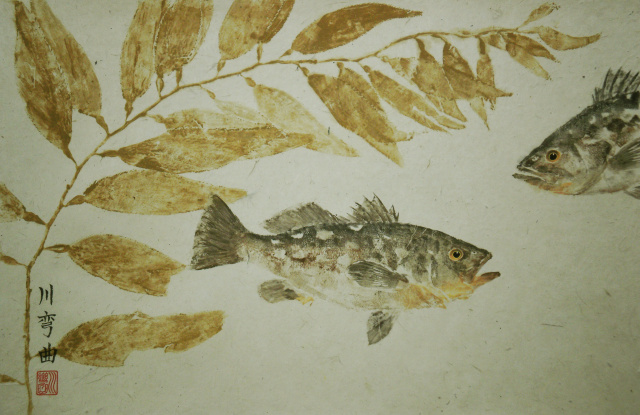
Kelp Bass (Paralabrax clathratus) swim within the dense cover of giant kelp (Macrocystis pyrifera) off the coast of southern California. Kelp forests are one of the most biologically productive ecosystems on earth; kelp bass and many other kinds of fish are nurtured by these underwater forests.
Although kelp possess chlorophyll and can produce their own food through photosynthesis, they are technically not part of the plant kingdom. Despite their tremendous size (individual giant kelp can reach lengths of over 150 feet), biologists generally agree that they are more similar to single-celled protists than to higher plants like trees. Kelp have a two stage life-cycle. The large kelp that you see is called the sporophyte stage because they release myriads of microscopic of spores. The spores develop into tiny, inconspicuous male or female plants called gametophytes attached to the bottom. The female gametophytes produce eggs that are fertilized by mobile sperm produced by the males. The fertilized egg develops into a mature sporophyte anchored to the bottom, thus completing the two-part life cycle. The sporophyte may live up to about seven years.
A structure called a holdfast attaches giant kelp to the bottom. The long “stem”, which is technically called a stipe contains the blades. The stipe and blades of giant kelp can grow phenomenally fast – an average of about 10 inches a day with a maximum of 24 inches. The largest giant kelp recorded with its holdfast still attached to the bottom was 65 m long (213 feet). Gas-filled bladders at the bases of the blades float and suspend the whole kelp upright within the water column.
Kelp forests provide food and refuge for a tremendous diversity of creatures great and small. Tiny filter-feeding animals attach to the blades. Small crabs and other invertebrates glean their food from the kelp surfaces. Fish that prey on these invertebrates and even larger fish that prey on smaller fish search for their meals within the forest. Sea otters diving from the surface hunt for sea urchins and mollusks that forage on the bottom. Even some of the largest sea creatures use kelp forests. Gray whales with calves have been observed to retreat to cover of thick kelp forests to escape from packs of hunting killer whales.
Human actions have affected kelp forests in ways that demonstrate a complex web of ecological relationships. A century or more ago, sea otter populations were hunted for their pelts to the point of near-extinction. Without the otters, populations of their favorite food, sea urchins, exploded. Sea urchins covered the seafloor, devouring everything including whole forests of kelp and the kelp disappeared. With the restoration of sea otters along the Pacific coast of North America, this situation has reversed. Nonetheless, humans continue to have an impact in various ways we use marine resources and treat the seas.
Size: 41 x 27 inches (2009)
Return to Gallery 2.